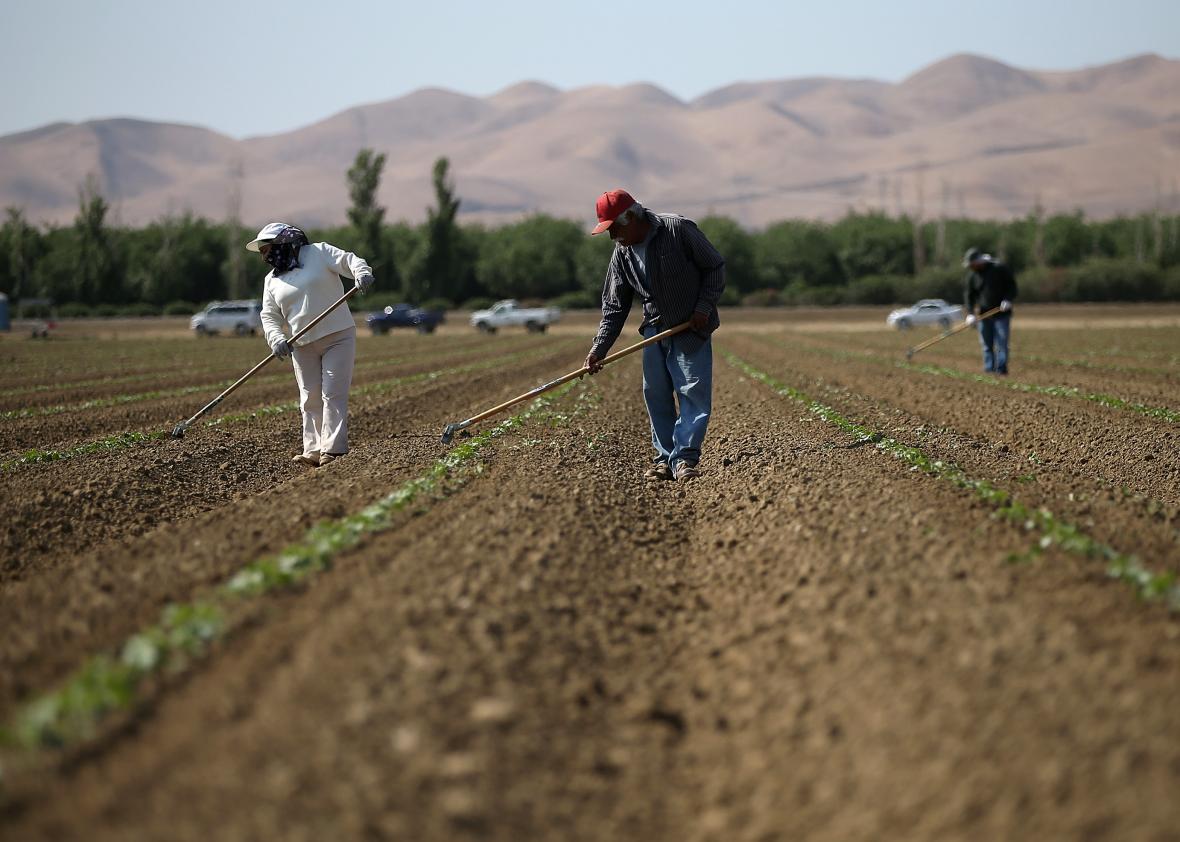Despite the arrival of increased rain and snow from El Niño this winter, California enters the fifth straight year of its worst drought in 1,200 years. The drought has been especially acute in the state’s Central Valley, which ranges from extreme to exceptional drought.
With its fertile soil, moderate climate, and unparalleled irrigation system, the Central Valley is one of the most productive agricultural regions on the planet, producing nearly all of America’s almonds, olives, walnuts, and pistachios; the vast majority of its grapes, strawberries, avocados, carrots, tomatoes, and lettuce; and $13.1 billion worth of milk and cattle. As a result of the drought, California’s 39 million residents are competing for fewer available water resources. Water prices have spiked, increasing tenfold in some areas.
The drought and the subsequent increased cost of water have led to declines in agricultural production across the state. According to the U.S. Department of Agriculture, production of oranges are down 9 percent, avocados down 13 percent, garlic down 6 percent, romaine lettuce 15 percent, and olives 29 percent in 2014—the most recent year on record—compared with the previous three-year average. The drought cost California’s farmers $1.5 billion in 2014 alone due to the combination of revenue losses from lower production and additional pumping costs.
The decline in California agricultural supply has resulted in higher prices for some fresh fruits and vegetables on supermarket shelves, but so far, the drought hasn’t led to a significant increase in food shortages or insecurity here or abroad. In fact, world food prices are currently at a seven-year low, according to the U.N.’s Food and Agricultural Organization. Two factors have helped mitigate the price changes caused by decreased agricultural production in California: substitution between goods and global markets.
First, unlike staple crops like wheat and rice, consumers can easily swap many of the products grown largely in California, like almonds and strawberries, for other nuts, fruits, and vegetables grown in areas not being hit by drought. Substitution isn’t just happening at the consumer level either. Producers in California are substituting away from traditional staples like oranges and avocados and towards fruits like grapes, pomegranates, and dragonfruit that use less water and are more economically productive. This is part of a longer-term trend, according to Daniel Sumner at the University of California–Davis, who notes that over the last two centuries, California has shifted away from wheat and cotton production to its current mix of crops.
Second, though California may be the biggest American producer of many crops, it is far from the only source of avocados, olives, or grapes internationally. As the USDA notes, though California produces 86 percent of American-grown avocados, 82 percent of the avocados consumed in the U.S. are imported from other countries like Mexico. Indeed, the U.S.’s imported share of fruits and vegetables such as olives, peaches, beans, and lettuce has grown with the drought. Though production costs may be increasing for California farmers, they haven’t changed elsewhere around the world. As the price of produce goes up due to the decreased supply of California goods, competing farmers from Latin America to Southeast Asia may now find it worthwhile to increase their production, even if their marginal costs are slightly higher, which helps limit the potential for shortages and price increases.
The reactions of California farmers, foreign producers, and domestic consumers to the drought highlight a few key lessons for food security moving forward. First, substitution and diversification are critical. Both producers and consumers have been able to shift to other agricultural products that cost less, use less water, and are more economically efficient than those hit hardest by the drought. Just like a stock portfolio, a more diversified agricultural portfolio and diet help limit vulnerability to major price fluctuations by any individual good in the basket.
While these two principles of substitution and diversification may work well for the nuts, fruits, and vegetables of California’s Central Valley, it also highlights the risk of supply disruptions to crops with few options for substitution, such as the three mega-crops of rice, wheat, and maize, which are responsible for half of the world’s calories. Wheat alone accounts for more calories and protein than any other crop on the planet, and as a result the demand for wheat is highly inelastic, making slight changes in the supply and price of wheat felt strongly throughout the world.
Relatedly, the global food supply chain can handle disruptions in one major breadbasket like California’s Central Valley, but food insecurity becomes a real challenge when drought, floods, or extreme weather events affect multiple major food producers at once. A major food security simulation run last fall by the Center for American Progress and the World Wildlife Fund highlighted how climate change is increasing the likelihood of simultaneous disruptions to major food producers. Part of the reason why wheat prices spiked so dramatically in 2010 was because three major wheat producers—Russia, Kazakhstan, and Ukraine—were all hit with extreme weather that reduced production at the same time.
Most Americans live in a state of blissful ignorance about the food that appears on our grocery store shelves. At best, we might think about which fruits and vegetables are in season, but rarely do we consider the global supply chain required to bring the food to market, the equilibrium of supply and demand that influence the prices we pay, or the delicate balance of heat, soil nutrients, and water required to grow each crop—and how those pieces of the puzzle might be changing forever.
We take our food security for granted until it’s not so secure anymore. The California drought didn’t cause any food riots, but it provides a window into the future of many other breadbaskets around the world. The best practices in conservation, substitution, and diversification we’re learning from California are the things we’ll increasingly need at a global scale to keep affordable food on the table.
